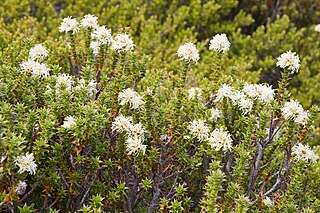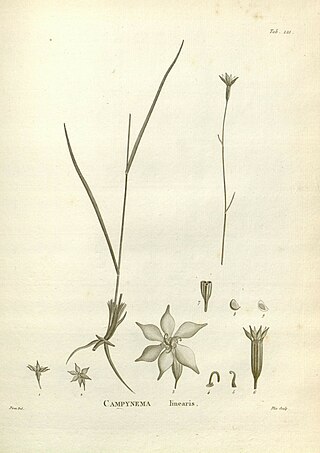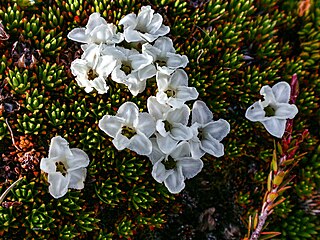
Eucryphia is a small genus of trees and large shrubs native to the south temperate regions of South America and coastal eastern Australia, mainly Tasmania. Sometimes placed in a family of their own, the Eucryphiaceae, more recent classifications place them in the Cunoniaceae. There are seven species, two in South America and five in Australia, and several named hybrids.

Lomatia tasmanica, commonly known as King's lomatia, is a shrub of the family Proteaceae native to Tasmania. Growing up to 8 metres (26 ft) tall, the plant has shiny green pinnate (lobed) leaves and bears red flowers in the summer, but yields neither fruit nor seeds. King's lomatia is unusual because all of the remaining plants are genetically identical clones. Because it has three sets of chromosomes and is therefore sterile, reproduction occurs only vegetatively: when a branch falls, that branch grows new roots, establishing a new plant that is genetically identical to its parent.

Athrotaxis is a genus of two to three species of conifers in the cypress family, Cupressaceae. The genus is endemic to western Tasmania, where they grow in high altitude temperate rainforests.

Nothofagus cunninghamii, commonly known as myrtle beech or Tasmanian myrtle, is the dominant species of cool temperate rainforests in Tasmania and Southern Victoria. It has low fire resistance and grows best in partial shade conditions.

Stylidium is a genus of dicotyledonous plants that belong to the family Stylidiaceae. The genus name Stylidium is derived from the Greek στύλος or stylos, which refers to the distinctive reproductive structure that its flowers possess. Pollination is achieved through the use of the sensitive "trigger", which comprises the male and female reproductive organs fused into a floral column that snaps forward quickly in response to touch, harmlessly covering the insect in pollen. Most of the approximately 300 species are only found in Australia, making it the fifth largest genus in that country. Triggerplants are considered to be protocarnivorous or carnivorous because the glandular trichomes that cover the scape and flower can trap, kill, and digest small insects with protease enzymes produced by the plant. Recent research has raised questions as to the status of protocarnivory within Stylidium.

The family Stylidiaceae is a taxon of dicotyledonous flowering plants. It consists of five genera with over 240 species, most of which are endemic to Australia and New Zealand. Members of Stylidiaceae are typically grass-like herbs or small shrubs and can be perennials or annuals. Most species are free standing or self-supporting, though a few can be climbing or scrambling.

Oreostylidium is a genus of flowering plants in the family Stylidiaceae with a single species, Oreostylidium subulatum, that is endemic to New Zealand. O. subulatum is a very small plant with small, white flowers. It has a complicated botanical history that has led to a few proposals to move Oreostylidium to the related genus Stylidium. The researchers cite molecular data and suspect that this species is an extreme example of floral paedomorphosis. This would not be an unprecedented move since the single species was initially described as Stylidium subulatum in 1864 and later moved to its own genus by Sven Berggren in 1878. It possesses the same kind of glandular trichomes underneath the flower that make Stylidium species carnivorous plants, but it has not yet been tested for the presence of digestive enzymes.

Donatia is a genus of two cushion plant species in the family Stylidiaceae. The name commemorates Vitaliano Donati, an Italian botanist.

Levenhookia dubia, the hairy stylewort, is a dicotyledonous plant that belongs to the genus Levenhookia. It is an ephemeral annual that grows from 2–6 centimetres (0.79–2.36 in) tall with obovate leaves that are generally 2–5 millimetres (0.079–0.197 in) long. Flowers are white and bloom from September to October in its native range. L. dubia is most closely related to L. sonderi, which has been described as a variety of L. dubia in the past. It is endemic to Australia and has native ranges in Western Australia, South Australia, New South Wales, and Victoria. Its habitat has been reported as being sandy soils in granite outcrops.

Stylidium perpusillum, the tiny triggerplant, is a dicotyledonous plant that belongs to the genus Stylidium, that occurs in south west Western Australia.

Forstera is a genus of small perennial plants in the Stylidiaceae family named in honour of the German naturalists Johann Reinhold Forster and his son, Georg Forster, who had previously described Forstera's sister genus, Phyllachne just five years earlier. It comprises five species that are endemic to New Zealand with the exception of F. bellidifolia, which is endemic to Tasmania. The species in this genus resemble those in a subgenus of the related genus Stylidium called Forsteropsis, but they are more closely related to the genus Phyllachne. Proposals to merge the two genera based on information from cladistic analysis have emerged because of these genera's morphological similarities and evidence that they are paraphyletic.

A cushion plant is a compact, low-growing, mat-forming plant that is found in alpine, subalpine, arctic, or subarctic environments around the world. The term "cushion" is usually applied to woody plants that grow as spreading mats, are limited in height above the ground, have relatively large and deep tap roots, and have life histories adapted to slow growth in a nutrient-poor environment with delayed reproductivity and reproductive cycle adaptations. The plant form is an example of parallel or convergent evolution with species from many different plant families on different continents converging on the same evolutionary adaptations to endure the harsh environmental conditions.

Donatia novae-zelandiae is a species of cushion plant in the family Donatiaceae and is closely related to species in the family Stylidiaceae. It is found in the alpine and subalpine regions of New Zealand and Tasmania. Donatia novae-zelandiae has free stamens and petals, paracytic stomata, and a pollen morphology distinct from the genera of the sister family Stylidiaceae. It was first described by Joseph Dalton Hooker in 1853 and published in his Flora Novae-Zelandiae.

Phyllachne colensoi, the yellow cushionplant, is a species of cushion plant in the Stylidiaceae family. It is native to both New Zealand and Tasmania, with colonisation of the latter being a somewhat recent dispersal. Phyllachne colensoi is frequently the dominant vegetation in upland bog habitats and is found throughout high mountain areas in New Zealand, but is only recorded from 12 sites in Tasmania in the west and south-west of the island.

The biodiversity of Tasmania is of exceptional biological and paleoecological interest. A state of Australia, it is a large South Pacific archipelago of one large main island and a range of smaller islands. The terrain includes a variety of reefs, atolls, many small islands, and a variety of topographical and edaphic regions on the largest island, all of which promote the development of unusually concentrated biodiversity. During long periods geographically and genetically isolated, it is known for its unique flora and fauna. The region's climate is oceanic.

Persoonia muelleri, commonly known as Mueller’s geebung, is a shrub endemic to Tasmania. It forms a shrub in open areas of wet forests in the west and northeast of the state. It is occasionally confused with P. gunnii though it has larger flowers and longer, straighter leaves.

Richea sprengelioides is a species of flowering plant in the family Ericaceae. It is one of the 11 species within the genus Richea that are endemic to Australia, of which 9 are found only in Tasmania.

Agastachys odorata, commonly known as the white waratah or fragrant candlebush, is the sole member of the genus Agastachys in the protea family. It is an evergreen shrub to small tree and is endemic to the heaths and button grass sedgelands of western Tasmania.

Campynema is a genus in the family Campynemataceae first described in 1805. It contains only one known species (monotypic), Campynema lineare, endemic to the island of Tasmania in Australia. Its closest relative is Campynemanthe, endemic to New Caledonia, sole other genus of the family.

Dracophyllum minimum, commonly known as heath cushionplant or claspleaf heath, is a species of bolster cushion plant endemic to Tasmania, Australia. It is a low growing, highly compacted plant with white flowers, commonly found in alpine areas of the south, centre and west of Tasmania.




















